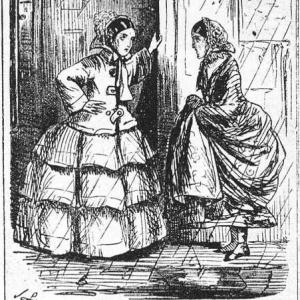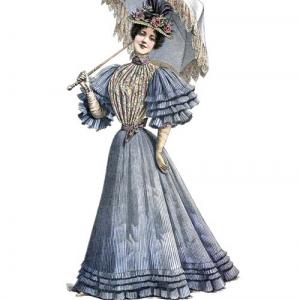This timeline will display the changes in fashion during the 1890s, and the way that these changes reflect cultural patterns of the time. Using illustrations from Punch and The Englishwoman's Review of Social and Industrial Questions, as well as information from original Victorian art journals and illustrations, the timeline will explore the idea of The New Woman, and how women's gained independence during the latter half of the 19th century impacted the clothing that was in style. This timeline was created in 2024 for ENGH/WGST 304: Sexuality and Gender in Victorian Literature and Culture, at Drew University.
ENGH/WGST 304 Sexuality and Gender in 19th-Century Literature and Culture (Kolmar, Drew University) Dashboard
Description



Through reading of nineteenth-century novels, poetry, prose, theoretical texts, and visual images, this course explores the complex and shifting understandings of gender and sexuality in the period. Among the topics considered will be the construction of heterosexuality and heterosexual marriage; marriage resistance and the ‘new women’; constructions of dominant and deviant masculinities and femininities; homosocial and homosexual love and homosexual panics; prostitution and the disciplining of female sexuality, suffrage and the campaigns for women's autonomy; as well as the codes, narratives, and images through which these are represented. The course will also ask how gender and sexuality have been deployed by twentieth/twenty-first century critics as lenses for reading the literature and culture of this period and how those approaches have shifted over time in dialogue with other critical approaches.
Galleries, Timelines, and Maps
This timeline is comprised of depcitions of Oscar Wilde in magazines such as Punch, Puck, Harper's Bazar, The Wasp, The Judge, Harper's Weekly, and The Illustrated Police News. The aim of this timeline is to present research surrounding the relationship between Oscar Wilde and flowers, as depicted in the aforementioned media of the time. The reason this is of interest is because of the history of the "pansy" stereotype in regards to gay men. The flower imagery at hand in these illustrations and texts---developing from sunflowers and lilies to lilacs to green carnations---allows us to fully understand Wilde's history with flowers, and what that may have meant when it came to the formation of the "pansy" stereotype.
Using the Jan-Jun 1879 volume and the Jul-Dec 1881 volume, this timeline highlights the socially acceptable realm of women in the early Victorian period, and how it changed over time. Using ads, articles, and illustrations from the Illustrated London News, it seeks to discover what was being marketed to women through the media as desirable, but is overwhelmingly a picture of upper-middle class ideals. This timeline was created in 2024 for ENGH/WGST 304: Sexuality and Gender in 19th-Century Literature and Culture at Drew University.
This timeline features a collection of images and written pieces representing the New Woman in the Victorian Era. Sarah Grand first coined the term “New Woman” in 1894. Despite this, the idea of the New Woman had already been pervading Victorian society years before, with the term’s meaning constantly fluctuating. What did it mean to be a New Woman? This collection, consisting of writing by prevalent authors Sarah Grand and May Kendall and Punch cartoons by various artists, explores the New Woman’s representation as existing not only in a liminal space between genders but in a space decidedly above men, causing resentment and mocking from traditionalist parties. This timeline was created by Grace Gannon in 2024 for Drew University's ENGH/WGST 304: Sexuality and Gender in Victorian Literature and Culture.
This digital timeline aims to examine public opinion on the New Woman as seen throughout political cartoons, essays, and reviews published from the years 1889 to 1897. During this timeframe of Victorian history, the New Woman was beginning to fully emerge and become a more common figure. At the same time, she was beginning to be both judged and defended by the public as they attempt to understand her. This timeline consists of 10 cartoons, reviews, and essays from both sides, following how the public's perspective on both sides continued to shift throughout history. The majority of sources were taken from Punch magazine, but others came from The Athenæum, The Fortnightly Review, and ...
moreThis is a collection of images from the London Labour and London Poor, by Henry Mayhew. All of the images are of women and/or girls that are working on the streets throughout the day, including those that are selling fruits on the street to performers on stilts. Mayhew's creation was divdied into 4 volumes published in 1851, mainly broadcasting workers in the 1840's.
This map is a collaborative project of the students in ENGH/WGST 304 at Drew University.
This timeine is a collaborative project of the Spring 2024 class. It will incorporate student-created entries related to the texts we are reading and provide contextual historical and cultural information for those texts.
